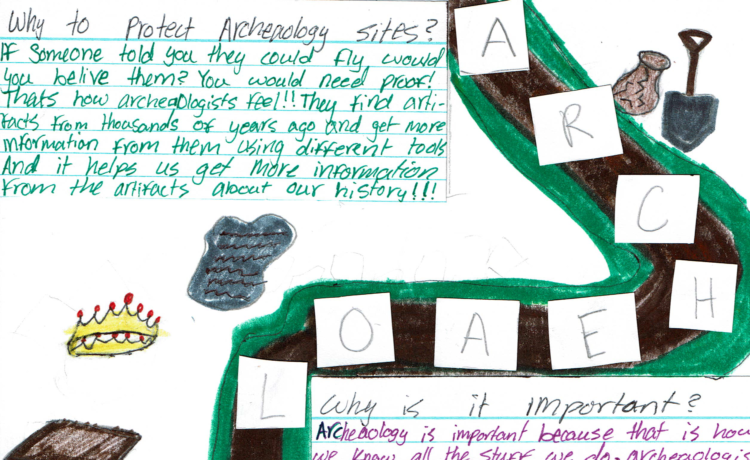By Julia Berg, 6th Grade Teacher at Bennett Middle School and Eastern Shore ASM Chapter Member
In Maryland, service learning isn’t just a requirement—it’s an opportunity for students to make an impact. Students in Maryland must complete 75 hours of service learning in order to graduate from high school. Many of those service learning hours occur through in-class projects and teacher-designed experiences. This year, I was thrilled that the Maryland Historical Trust partnered with me – a middle school teacher in Salisbury, MD – to bring a unique service learning project to life.
As an active member of the Archeological Society of Maryland and a frequent volunteer on MHT digs, I’m always looking for ways to incorporate archaeology into my 6th grade history classroom. My students know about my passion for archaeology and historic preservation from day one, but since my class focuses on ancient civilizations like Mesopotamia, Egypt, China, and Greece, I rarely get the chance to highlight Maryland archaeology. When it came time to plan my service learning project for the year, I reached out to my friend Stephanie Soder, Research Archaeologist at MHT, with an idea. My initial rambling email, which ended with “feel free to tell me that this is a stupid idea,” quickly blossomed into a collaborative effort that was both fun and meaningful for me, my students, and the MHT team. After some back and forth refining the details and logistics, we were ready to launch the project.
The Inspiration
I was inspired by a 7th grade science project at my school – a contest where they designed artwork for stormwater drains to promote Chesapeake Bay conservation. I wanted to create something similar but focused on archaeology. My idea: a poster contest where students would design PSA-style posters advocating for the protection of cultural resources and artifacts. The theme: “Guardians of History: Create a poster showing how we can protect ancient artifacts and sites.” After multiple lessons on archaeology – including a hands-on mock dig in sandboxes – students were equipped with the background knowledge and enthusiasm to help protect Maryland’s archaeological resources.
The Process
Students had the option to create their posters using Canva, Google Slides, or traditional hand-drawn methods (although some got even more creative and added construction paper details!). They had two class periods to work on their designs, as well as additional time at home for finishing touches. The true game-changer? The MHT team agreed to serve as the judges for the contest, and their wholehearted enthusiasm and support is really what gave the project a layer of authenticity that I never could have achieved on my own. Knowing that “real archaeologists” would evaluate their work energized the students. They felt like active contributors to a cause rather than just participants in a class assignment. The relationships I’ve built with the students throughout the year also played a role in their motivation – they knew how much this project meant to me, which also made them more invested. Kids thrive on feeling useful and important, and this project really gave them a sense of shared ownership over Maryland’s history.
The Judging
Once completed, the final products were uploaded to a shared folder, and Steph coordinated MHT’s archaeologists and the Office of Planning, Education, and Outreach to form a judging committee. I worried that this might feel like a burden to them – an annoying chore they were just doing as a favor to me – but it seems like they genuinely enjoyed the process! They used a rubric I developed, scoring posters on relevance to the theme, creativity, visual appeal, clarity of the message, and general accuracy in portraying archaeology. Many of the entries had great messages, but were too wordy or text-heavy. Some featured entirely too many dinosaur bones for the archaeologists. A handful struggled to differentiate between “artifacts that would be found in Maryland” from “artifacts from ancient civilizations like Egypt and China.” But overall, the students embraced the message: leave the artifacts to the professionals.
Looking Ahead
For a pilot project, I’m thrilled with the outcome. The students’ engagement, the MHT team’s support, and the overall impact exceeded my expectations. With a few tweaks, I’d love to replicate and refine the project next year to make it even smoother. Bringing archaeology into the classroom in such a hands-on, student-driven way reinforced the importance of preservation while giving students a real-world task and audience for their work.
Discover more from Our History, Our Heritage
Subscribe to get the latest posts sent to your email.



















